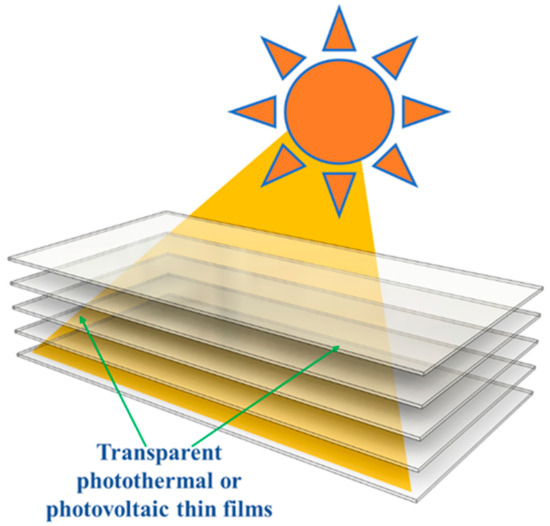半導体は集積密度を上げるために3Dの構造に向かい始めたが
ソーラーはもっと徹底的に3Dの方向に向かっている。
透明薄膜を重ねていくのだ。10枚重ねれば10倍の効率になる。100枚なら100倍だ。
アイデアは単純だが材料ができてこそ現実のものとなる。
3D Solar Harvesting and Energy Generation via Multilayers of Transparent Porphyrin and Iron Oxide Thin Films
The Materials Science and Engineering Program, Department of Mechanical and Materials Engineering, College of Engineering and Applied Science, University of Cincinnati, Cincinnati, OH 45221, USA
Abstract
Photovoltaic solar cells have been extensively used for various applications and are considered one of the most efficient green energy sources. However, their 2D surface area solar harvesting has limitations, and there is an increasing need to explore the possibility of multiple layer solar harvest for enhanced energy density. To address this, we have developed spectral-selective transparent thin films based on porphyrin and iron oxide compounds that allow solar light to penetrate multiple layers, significantly increasing solar harvesting surface area and energy density. These thin films are designed as photovoltaic (PV) and photothermal (PT) panels that can convert photons into either electricity or thermal energy for various green energy applications, such as smart building skins and solar desalination. The advantages of this 3D solar harvesting system include enlarged solar light collecting surface area and increased energy density. The multilayer system transforms the current 2D to 3D solar harvesting, enabling efficient energy generation. This review discusses recent developments in the synthesis and characterization of PV and PT transparent thin films for solar harvesting and energy generation using multilayers. Major applications of the 3D solar harvesting system are reviewed, including thermal energy generation, multilayered DSSC PV system, and solar desalination. Some preliminary data on transparent multilayer DSSC PVs are presented.
Keywords:
spectral-selective solar harvesting; multilayer system; photothermal energy generation; 3D desalination
1. Introduction
To produce clean energy and develop sustainable green/blue infrastructures, solar energy utilization has been a popular approach due to its technical, environmental, and ecological advantages [1,2,3,4,5]. Photovoltaic (PV) solar cells have been widely used for various applications, including solar energy utilities [6,7,8,9]. However, the 2D surface solar harvesting of PV cells has limitations. To meet the total yearly electricity demand of the United States, an estimated 13,600,000 acres of solar panels would be required assuming 4 petawatt hours of electricity per year [10]. However, not all lands are available for solar cells, particularly in densely populated megacities where limited roof space can reduce the potential for solar harvesting. In such cases, alternative solutions, such as community solar gardens or building-integrated photovoltaics (BIPV), may be needed to meet the energy needs of the city [11,12,13,14,15,16,17,18].
There is a growing need for more efficient solar harvesting approaches that can significantly increase photon collection area within a confined volume. Multilayer photovoltaic (PV) and photothermal (PT) solar harvesting offer a way to increase the energy density of a solar system by stacking multiple layers of PV or PT films on top of each other. This results in more compact and efficient use of space compared to traditional single-layer solar panels. Transparent thin films allow solar light to pass through multiple layers for either PV or PT photon conversion and energy generation. By stacking multiple layers, the PV and PT films can increase the amount of electricity or thermal energy generated per unit of volume.
Both photothermal (PT) [18,19,20,21,22,23,24,25,26,27,28,29] and photovoltaic (PV) thin films [1,2,3,4,5,30,31,32,33,34] have been used for solar harvesting and energy generation. The former converts photons to thermal energy while the latter generates electricity through different mechanisms, with both characterized by power conversion efficiency (PCE). To achieve solar harvesting in a three-dimensional (3D) fashion, spectral-selective transparent thin films have been developed, analogous to multilayer capacitors that increase the total surface area within a finite volume. As shown in Figure 1, sunlight can pass through multiple layers of transparent substrates and generate energy through either PT or PV. For multilayer solar harvesting, both PT and PV thin films need to be transparent with high average visible transmittance (AVT). Furthermore, specific optical characteristics of PT or PV are required for optimal energy conversion. For a highly transparent PT film, absorptions should be concentrated in the UV and IR regions for photon conversion to thermal heat, while those in the visible band should be kept at a minimum for high AVT.

Figure 1. Schematic diagram showing the concept of 3D multilayer solar light harvesting.